Tuesday, April 23, 2019
When Parents Cannot Let Go: Insights Highlighted by the College Admissions Scandal
from The New Social Worker Online — the professional social work careers magazine http://bit.ly/2URux8H
Marketing Tips to Glean Graduates

Graduation 2019 is around the corner - start booking trials and Graduation Day appointments now. Graduation season begins in May and runs through the month of June. Providing special graduation day services provides an opportunity to introduce your salon to students of all ages - this is especially relevant to salons located in college-towns. This walk across the stage serves up a huge opportunity to offer ‘celebrate the graduate packages can bring extra business to your beauty business the last weeks of spring.
Junior high, high school, college and university graduates across the country are spending money on men's and women's hair, makeup, brow shaping, facials, sunless tanning, manicures and pedicures. Be sure to build the Graduation season into your marketing calendar every year. Here are a few ways:
1) Offer Special Graduation Promotion Packages.
Creating affordable packages geared toward students generates new business, use graduation season as a chance to connect with students directly. Put together packages at 3 different price points and secure appointments with a 50% deposit (non-refundable).
2) Referrals Rock.
Talk up your graduation services and promotions to current clients starting several weeks in advance. Word of mouth is one of the best ways to market your business. Try a friend referral offer for graduation services. For example: Schedule graduation services for yourself and a friend, receive Lash Application for free.
3) Offer special splurges.
If there’s ever a time that a student to splurge for a fancy hair clip, earrings or lip gloss, it’s for graduation. Even if you don’t typically stock these kinds of items, investing in some beauty accessories and displaying attractively in key retail area/s boosts the bottom line every time.
4) Check the dates for local graduations.
Call your local junior highs, high schools, colleges and universities to ask graduation ceremony dates. These dates will change every year, so in order to plan and staff accordingly make sure these dates are highlighted in your calendar.
5) Socialize.
Target graduates by posting "graduate-related" content May - June. Share inspirational quotes, congratulations and graduation planning tips. Facebook ads are a great place to start advertising special graduate offers and services.
6) Graduation Packages Email.
When the time comes to plan graduation day beauty services make sure your salon is “top of mind” of regional graduates. Send an e-mail campaign to promote your graduate packages. For easy booking offer simple price points with memorable package names such as "Top of the Class", "Follow Your Dreams", "Valedictorian", or "One Smart Cookie". Get creative!
7) Gift Cards for Grads.
Gifts for high school and college students should be highlighted at this time as well. Gift cards are the perfect gift, remind gift givers by displaying prominently with graduation cards.
from Beauty Business Blog http://bit.ly/2PqfCfv
Monday, April 22, 2019
Clinical Intersections: Grief, Trauma, and Complex Trauma - 5 Questions & Answers for Social Workers
from The New Social Worker Online — the professional social work careers magazine http://bit.ly/2L5LebE
Saturday, April 20, 2019
Top Five Ways to Spend Your Dry Day in Raja Ampat
Most divers know of Raja Ampat, one of the world’s best scuba-diving destinations. This Indonesian archipelago is also known as the Four Kings. Justifiably, it attracts scuba enthusiasts from around the world who dream of a colorful and abundant underwater wonderland. Raja Ampat’s spectacular marine world gets a lot of attention from journalists, photographers, and scuba fans, but Raja offers equally stunning topside attractions. If you’re planning a land-based trip here for your next scuba adventure, stay near Waigeo to enjoy some of these unique topside attractions.
Pianemo
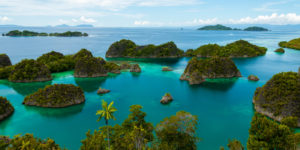
Pianemo offers iconic Raja scenery.
You may have seen iconic photos of a cluster of island mounds floating in an ocean of turquoise. Photos of Pianemo represent Raja Ampat in almost every media outlet, travel magazine, and marketing tool. And understandably so, as the view from the top of Pianemo leaves most people speechless.
If you’re staying in any of the islands around Waigeo, you can hire a speedboat to take you to Pianemo. From the main town of Waisai in Waigeo, the trip can take about 1.5 hours one way. Even though Pianemo has become a bit touristy, the view makes the trip worthwhile.
Arborek village
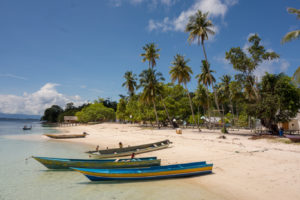
Local village in Raja (Credit: Mo Ohashi)
As part of the Indonesia government’s tourist program, the tiny island of Arborek and its native Papuan habitants offer performances with traditional dance and music to introduce visitors to a unique cultural experience. The white-sand beaches surrounding the island, the local village life, and stunning reefs just offshore make this enchanting island a must-visit if you are staying in Waigeo. Arborek village also offers simple accommodations, souvenir shops, small stands for snacks and drinks and even a dive center. Conveniently located en route to the famous Pianemo, Arborek makes for a great stopover.
Bird watching
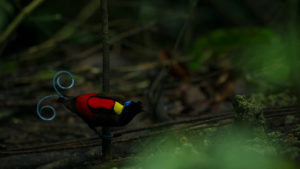
Wilson’s bird of paradise competes to attract a female by dancing on the forest floor.
Raja Ampat is home to endemic Birds of Paradise (Cendarawasih) which, according to National Geographic, are “some of the world’s most dramatic and attractive birds.” Aside from the colorful and vibrant colors, the Cendarawasih birds are also renowned for being fabulous dancers and singers. Of the 41 Cenderawasih species in Indonesia, 37 live in the Papua region alone. Two of these species in particular — Wilson’s Bird of Paradise and Paradise Red — are endemic to Raja Ampat. They most commonly live in the jungles of Batanta and Waigeo.
Since these rare birds appear mostly in the early mornings from around 5:30 to 6:30 am, you can even squeeze in a birdwatching tour before you dive. Many local guides will be happy to show you around.
Jungle exploration
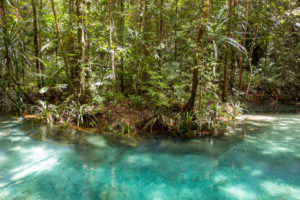
Kalibiru River lies deep in the jungle. (credit: Mo Ohashi)
Much of Raja remains relatively untouched and unexplored rainforest, abundant with fascinating wildlife and plant species. In the thick jungle of Waigeo, you can find Kalibiru, the highlight of my last trip to Raja Ampat. This crystal-clear, turquoise freshwater river runs through the lush, green forest. Even more spectacularly, you can watch this river originating from the ground, gushing out between the rocks and dirt at your feet.
Island hopping

Island hopping in Raja means visiting paradises like this. (credit: Mo Ohashi)
Aside from the four main islands that make up Raja Ampat, smaller islands are also dot the region. Most have beautiful lagoons, white-sand beaches, and shallow reefs. Often, you can simply jump in with your mask and snorkel and encounter reef sharks, turtles, and even dugongs if you’re lucky.
Hire a speedboat for the day and explore some of the remote, uninhabited islands, with some of the planet’s most stunning shades of blue. No matter how you choose to spend your topside time in Raja Ampat, it will not disappoint you.
Mo Ohashi is a Bali-based scuba instructor whose current passions include coconut ice cream, rescuing street dogs, and sharing her travel tips and resources on Travelust 101. You can follow her adventures on Instagram and contact her for tips on guides for Kalibiru.
The post Top Five Ways to Spend Your Dry Day in Raja Ampat appeared first on Scuba Diver Life.
from Scuba Diver Life http://bit.ly/2KUsXOz
Thursday, April 18, 2019
Keep On Walking
from The New Social Worker Online — the professional social work careers magazine http://bit.ly/2GfThwU
Preserving America’s Underwater Battlefield: E.M. Clark
From January to the end of August 1942, German U-boats attacked more than 285 vessels in North American waters. Just off coastal North Carolina, the remnants of many of these ships are scattered on the ocean floor. The remains of this little-known battlefield serve as the final resting place for 90 ships and nearly 1,700 men lost during the Battle of the Atlantic. Over the course of the battle, eight Allied convoy vessels, 78 merchant freighters and tankers and four German U-boats sank off North Carolina’s coast. Each shipwreck tells a unique story; today we visit the E.M. Clark.
E.M. Clark sinks
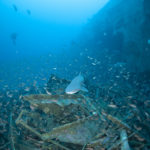
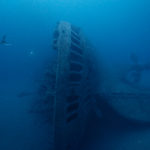
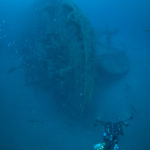
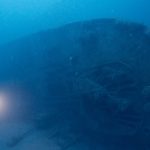

During World War II, E.M. Clark was part of a larger transportation network that carried petroleum products to support the Allied war effort both at home and abroad. Standard Oil Company of New Jersey owned the ship, which made 41 voyages from 1939 to 1941, carrying over 4 million barrels of petroleum products. In 1942, E.M. Clark completed two trips, but its third trip for the year would it be its last.
On March 11, 1942, E.M. Clark left Baton Rouge, Louisiana carrying 118,000 barrels of heating oil destined for New York. As darkness fell the evening of March 17, the ship encountered rough seas and lightning as it approached the Diamond Shoals Light Buoy. Around 1:00 am, U-124, lurking just southwest of the buoy, spotted E.M. Clark traveling alone. Using the squally weather conditions, U-124 moved close to E.M. Clark and fired one torpedo that tore into the tanker’s port side four feet below the waterline.
The exploding torpedo buckled the deck and brought down the foremast and radio equipment. While the crew attempted to rig an emergency radio distress signal, another torpedo ripped through the stricken vessel at the bow. The ship was fatally wounded and sank in just 10 minutes.
By the time E.M. Clark was bow down in the water, the sea was covered in oil, making the men in the lifeboats sick from the fumes. U-124 surfaced and for about an hour and a half circled E.M. Clark and its lifeboats. The submarine was last seen at 3:00 a.m. heading northwest looking for another target. Of the 41-man crew, 40 survived and were rescued. The USS Dickerson rescued 14 survivors and the Venezuelan tanker Catatumbo rescued the other 26.
Diving the E.M. Clark
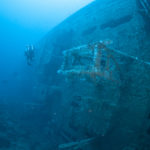
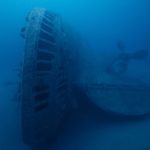
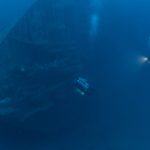
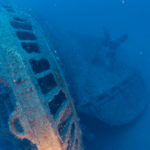
Resting on its port side in about 240 feet (73 m) of water, E.M. Clark is completely intact from bow to stern. It is one of the best representations of a World War II merchant ship off the North Carolina coast. Although the depth of the shipwreck will prohibit all but the most experienced technical divers from exploring the site, E.M. Clark nonetheless offers the technical diver a unique dive experience on a very well-preserved shipwreck.
“Visibility at the wreck site is stunning,” says Tane Casserley, Monitor National Marine Sanctuary’s research coordinator and NOAA diver.
“When you start at the bow, the prevailing current helps you to glide along the wreck, allowing you to truly experience the wreck and all the marine life. As you move toward the stern, the wreck begins to disappear behind you. Then you come to the fantail, which is beautiful. To me, the architecture of that section looks like the Statue of Liberty’s crown and offers a vivid reminder of why World War II was fought and why we work so hard to protect these shipwrecks.”
The site of E.M. Clark measures 499 feet long (152 m) and the site’s main feature is the steel hull, which lies mostly intact on its port side. The hull’s exterior steel plates are in excellent condition with only small areas of deterioration. The wreck’s highest point is the starboard side main deck, which sits at least 50 feet (15 m) off the seafloor.
The bow’s starboard anchor is in place and visible in the hawse pipe. The port-side anchor is buried in the sand under the vessel. Both anchor chains run up through the hawse pipes to the deck, where they wrap over the windlass and continue down into the chain locker. The deck plating in the bow has deteriorated, exposing beams and cross bracing. Additionally, there are large holes in the top of the main deck that allow access to interior compartments.
Moving aft, the bridge structure has fallen to the seafloor. Only the outline of where the bridge met the deck indicates where the superstructure once sat. The bridge and all of the associated components, including stateroom and pilothouse materials and portholes, are scattered on the seafloor in a large pile. The main deck planking in this area has also eroded away, exposing the interior of the empty cargo tanks.
All three of E.M. Clark’s masts have fallen over and lie on the seafloor. The skylight that sat above the engine room is gone, resulting in a large opening 20 feet (6 m) wide. The large, single rudder and two propellers and shafts are intact. The entire starboard propeller remains visible, but only half of the port side propeller protrudes from the sand.
Marine life on the E.M. Clark
Lying near the western margin of the Gulf Stream, the warm water and the remains of E.M. Clark make the perfect home for an ecosystem teeming with life. The artificial reef supports encrusting invertebrates and a wide variety of fish and sharks. This, coupled with the site’s historic significance, make this a popular spot for technical divers looking for an intact World War II shipwreck.
As with other World War II shipwrecks, E.M. Clark is a war grave. Visitors should not disturb the site, leaving the wreck and its artifacts in place for future generations.
In July 2013, NOAA’s Office of National Marine Sanctuaries nominated E.M. Clark for listing on the National Register of Historic Places and it was accepted. To learn more about the E.M. Clark and other World War II shipwrecks off the North Carolina coast, click here.
An expanded sanctuary
In an effort to honor the service and sacrifice of those lost during the Battle of the Atlantic, NOAA in 2019 will release a draft proposal to expand the boundaries of Monitor National Marine Sanctuary to include a nationally significant collection of shipwrecks that currently have little or no legal protection. The expansion would also establish the largest area designated as a World War II battlefield anywhere in the world.
To learn more about the proposal, click here.
By Shannon Ricles, Monitor National Marine Sanctuary
The post Preserving America’s Underwater Battlefield: E.M. Clark appeared first on Scuba Diver Life.
from Scuba Diver Life http://bit.ly/2GmuGXz
Wednesday, April 17, 2019
Social Work, Inc.: How Benefit Corporations Grow Your Business With Social Responsibility
from The New Social Worker Online — the professional social work careers magazine http://bit.ly/2InBWpm
Maximize Mother's Day

In North America Mother’s Day is one of the biggest “gift giving” holidays of the year. Salons and spas are perfect businesses to benefit from a Mother’s Day promotion that translates services and retail products into great Mother’s Day salon or spa packages. Remind consumers that gift cards, service packages and pampering retail products make memorable gifts for moms, grandmothers, aunts, wives and daughters.
Marketing studies tell us that Mother's Day spending peaks in the week between the 5th and the 12th of May so make sure to implement your Mother's Day campaign as soon as possible. Make this year’s Mother’s Day the most successful one yet, attract the right consumers to your salon for their gift-giving needs.
TIP #1 Cover All Budget Types
Divide up your service and product selections for all budgets, provide package options in different amounts to cover all budgets types.
TIP # 2 Think MEN
Remember that men purchase a significant portion of Mother’s Day gifts overall, put your Mother’s Day campaign in the windows in the form of posters to get walk-by traffic to walk-in. Market directly to men with a “stressed to the max wife” Mother’s Day hair or spa package.
TIP #3 Promote Everywhere
Promote your salon or spa Mother’s Day specials on all marketing channels including social media, website, and “in-store”.
1) Update website homepage slideshow to include image of Mother’s Day promotion
2) Post Mother’s Day promotion on all social media channels.
3) Create Mother’s Day promotional signage for windows and mirror talkers for individual stations.
4) Create scripts for staff to help them start the conversation about Mother’s Day behind the chair or at the point of purchase.
TIP #4 Gift Cards
Did you know that the most popular time for Mother's Day gift card sales is Mother's Day “eve”? Make sure it’s easy to purchase gift certificates in person and from your website. You should have both print and email delivery options available. Gift cards can be a big money making opportunity for salons if panicked gift givers can access your salon’s website and purchase a thoughtful gift for their loved one.
TIP #5 Mother’s Day Email
Send out an e-mail campaign announcing your Mother’s Day gift options. Remember that most sales for Mother’s Day will be at the last minute. Promote your salon or spa’s Mother’s Day packages or gift cards as perfect “last minute” gift options.
Run your campaign like this:
Email 1: May 1: Mother's Day Campaign Launch
Email 2: May 9: Only 3 Days left!
Email 3: May 12: Last 24 Hours Last Minute Gifts = Gift Cards
TIP #6 Pre-Made Mother's Day Campaigns
It's not too late to capitalize on Mother's Day in your salon with pre-made campaigns from BeautyMark Marketing. Learn more here


beauty business, beauty salon email marketing, mother's day marketing, mother's day marketing ideas, mother's day promotions, mother's day tips, salon email marketing, salon marketing ideas for mother's day, salon promotions for mother's day mother's day marketing, salon promotions for mother's day, mother's day business tips
from Beauty Business Blog http://bit.ly/2Xm3gYI
Dialogues on Gun Violence: The Role of Social Work Values and Principles
from The New Social Worker Online — the professional social work careers magazine http://bit.ly/2UIbsW7
A Matter of Speaking: For Social Workers, How To Give a Presentation With Confidence, Humor, and Impact
from The New Social Worker Online — the professional social work careers magazine http://bit.ly/2GkmqqS
Say You’re a Social Worker
from The New Social Worker Online — the professional social work careers magazine http://bit.ly/2UIbUUj
Assessing for PTSD in Terminally Ill Patients
from The New Social Worker Online — the professional social work careers magazine http://bit.ly/2GwGkzh
How To Train the Technology Monster We Cannot See
from The New Social Worker Online — the professional social work careers magazine http://bit.ly/2UIbTjd
The Intersection of Autoimmune Disease and Social Work: An Effective Partnership for Health
from The New Social Worker Online — the professional social work careers magazine http://bit.ly/2GpVIxk
Will I Have a Social Work Legacy?
from The New Social Worker Online — the professional social work careers magazine http://bit.ly/2UIbSf9
Book Review: Dare to Lead
from The New Social Worker Online — the professional social work careers magazine http://bit.ly/2GirWKF
Book Review: White Fragility
from The New Social Worker Online — the professional social work careers magazine http://bit.ly/2UIbRb5
Book Review: Older, Wiser, Shorter
from The New Social Worker Online — the professional social work careers magazine http://bit.ly/2UEK3oa
Monday, April 15, 2019
Self-Care A-Z: 5 Harmful Self-Care Myths
from The New Social Worker Online — the professional social work careers magazine http://bit.ly/2X97G54
Sunday, April 14, 2019
Choosing Regulators for Technical Diving
Buying recreational diving equipment is both daunting and exhilarating, and it’s no different when it comes to technical diving equipment. We took a look at the topic a little while ago, and here we’re going to delve a little deeper on how to go about choosing regulators for technical diving.
The basics
As a recreational diver, you may already own a set of regulators. Generally, this consists of a first stage, two second stages — one of which is mounted on a longer hose — a high-pressure hose for your submersible pressure gauge (SPG) and maybe a console plus one or two low-pressure inflator hoses for your BCD and your drysuit, if you’re diving in cold waters.
As an open-circuit technical diver, you will be carrying more than one tank, and consequently, you will be using more than one set of regulators. Each set has slightly different components depending on its purpose, but all will consist of a first stage, a second stage and a high-pressure hose with SPG — with one exception we’ll get to later in this post.
Which components are part of your individual regulators depends on when you are planning to use them on the dive. Roughly speaking, you can divide tech dives into three phases: the bottom part, travel to and from the bottom part, and the decompression phase.
Bottom or back-gas regulators
Bottom, or ‘back-gas,’ regulators attach to your twinset or your main sidemount tanks. While the term bottom gas is pretty self-explanatory, ‘back-gas’ refers to the fact that the twinset containing this gas is usually on your back.
Whether you are diving air, nitrox or trimix, these are the regulators that you will be using during the deepest phase of your dive, when your breathing gas is most dense and therefore hardest to breathe. That means you are looking for high-performance regulators that can deliver a lot of gas to allow you to breathe as easily as possible. Your choice of gas obviously influences breathing ease, but your regs have a role to play as well.
Regulator configuration
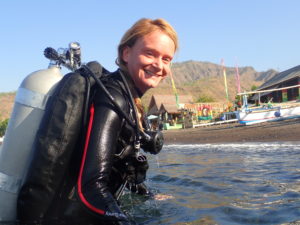
The author models twinset configuration on a dive. (Credit Heather Sutton)
If you are diving twinsets, you need a first stage each for your left and right tank, also called left and right post. While there are some variations, most tech divers will have a second stage with a 7-foot (2 m) hose on the right as well as their inflator hose leading to their wing. The long hose connects to the second stage that tech divers generally breathe from. The hose is longer to allow divers to share gas and exit a restriction while swimming behind each other.
The left tank typically holds a second stage on a short regulator hose with a ‘necklace’ made from bungee cord or surgical tubing, as well as a high-pressure hose and an SPG. There may also be another inflator hose here for a drysuit or the second bladder of the BCD if it has one. The necklace allows the diver to easily reach their second stage in case they need to donate their long hose.
Did you notice there is no SPG on the right post? When diving manifolded (connected) twinset tanks, the diver accesses gas from both tanks through one regulator as long as the manifold isolator valve is open. This means that as long as there is no equipment failure, one SPG is enough.
Sidemount setups
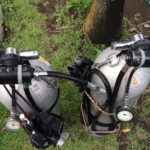
Sidemount setups can vary more as the configuration in general is more individual. One common option, however, is to rig the right tank with a first stage, a second stage on a long hose, and an SPG on a short high-pressure hose, usually about 6 inches (15 cm) long. There may also be an inflator hose for a drysuit or a second BCD bladder here.
On the left tank is a first stage with a second stage attached to a short hose and again equipped with a necklace. Often, there is an angled ‘elbow’ piece between the second stage and the hose, allowing divers to easily identify which tank they are breathing from. Additionally, there is a short high-pressure hose with an SPG and an inflator hose connecting to the sidemount harness and wing.
Many sidemount divers run their inflator across their body rather than over their shoulder. This means that suitable regulators often have a fifth low-pressure port at a right angle to the other ports. It’s also easier to streamline a sidemount setup by using first stages that have the capacity to swivel and therefore allow cleaner hose routing.
Some manufacturers have started offering dedicated twinset and sidemount regulator sets. This is a good way to purchase all the bits and pieces in one go. In the case of twinset regulators for example, they might have low-pressure ports pointing downward at an angle for better hose routing. Sidemount sets will have swiveling first stages with five low-pressure ports, one of which is at a right angle.
Deco regulators
Regulators for the decompression phase of the dive generally feature a first stage, second stage on a somewhat longer hose (octopus length) and an SPG on a short high-pressure hose.
Tech divers use these regulators with oxygen-rich nitrox mixes to help accelerate decompression and, therefore, the units must be suitable for use with oxygen. In practice, this means choosing a regulator that is made of a material with a high flash-point – titanium, for example. The regulator must also be cleaned for oxygen use, and any O-rings and greases used in the process must be oxygen-compatible. Not every regulator will be suitable fresh out of the factory, so it’s important to check on this when you are buying your deco regs.
As we generally use these regulators on shallower parts of the dive, we can use unbalanced first stages. However, this is still life-saving equipment, so the general recommendation to buy the highest quality possible while remaining practical.
Travel gas regulators
Trimix divers usually use ‘travel gas,’ a breathing gas that does not contain enough oxygen to sustain life on land. Their components will often resemble deco regulators, although they may not need to be oxygen-clean depending on the gases the diver uses.
If all that sounds daunting, consider this: you can usually rent equipment for your tech courses from the instructor or shop that is conducting the course. Most budding tech divers qualify initially to dive a twinset or sidemount tanks for the bottom part of the dive and one deco gas, so that’s ‘only’ three regulators. Additionally, you may be able to reconfigure some of the components you already own.
Last, but not least, consider where you will be diving. If you’re going to be in cold water, make sure your regs are suitable for that. If you will be spending a lot of time in remote areas, some brands will be easier to maintain than others due to the availability of spare parts and service technicians.
The first step when it comes to choosing regulators for technical diving is to speak to your instructor and other tech divers about what they use. Spend some time researching before going on that shopping spree. One thing is for sure — as your tech diving journey continues, your gear bag will only expand.
The post Choosing Regulators for Technical Diving appeared first on Scuba Diver Life.
from Scuba Diver Life http://bit.ly/2UGTGTu
Friday, April 12, 2019
Digital Media India: Publishers share subscription success stories
from World News Publishing Focus by WAN-IFRA - World Association of Newspapers and News Publishers http://bit.ly/2GjGQl2
Training Fundamentals: Keeping a Dive Log
Logging dives — recording essential details of each individual dive for future reference — is mandatory during open-water training. A qualifying instructor must then sign the dive log once the student has satisfactorily completed the dives. But as our diving careers progress, unless completing a continuing-education course, the dive log becomes something more personal for divers. Following initial training, many divers fail to log dives at all, seeing it as an unnecessary chore or meaningless exercise.
However, logging dives has multiple benefits. It is a good habit worth continuing and cultivating as you progress in your dive career. And, as a bonus, it will also pay dividends if you’re considering pursuing divemaster level training or beyond in the future. Here are some of our top reasons you should be keeping a dive log.
Proof of experience

An up-to-date dive long can be a valuable training resource and personal journal.
There is no substitute for experience. An up-to-date dive log illustrates the type and frequency of your diving experience. It’s not about bragging rights on the dive deck, however. In some circumstances, dive center owners, trip leaders, guides, boat captains and tour operators will insist on a certain level of experience before permitting divers to undertake a specific dive or trip itinerary.
For example, liveaboard operators may request a minimum number of logged dives before allowing guests to dive in environmentally challenging conditions. If you’re diving somewhere with low visibility, low temperatures or strong currents, for example, an operator might seek proof of experience.
On liveaboard vessels, the trip leader will typically verify a diver’s certification card upon check-in. However, the trip leader may also sometimes request a look at the diver’s log book too. This allows them to establish when the diver was last in the water or if may need a refresher course. Log books can also establish the diver’s experience level, as the type, depth and duration of dives in the log book provides the trip leader with clues about the diver and style of diving they’re accustomed to.
Instructors, trip leaders and guides aren’t usually interested in the precise number of dives you’ve completed. However, experienced trip leaders will often use logbook information to help tailor the itinerary and dive-site selection and make professional judgements on the suitability of conditions before the boat has even left the harbor.
If you intend to pursue further levels in diving, such as divemaster or instructor, you must have evidence of a certain number of logged dives.
Remembering equipment and configuration
During your initial training, you’ll learn how make sure your equipment fits correctly. As a certified diver, operators will expect you to know your sizes. Therefore, during your course, write down the equipment you’ve been using in your logbook, together with the weighting that was effective with that equipment and in that environment. Note the size and type of BCD, exposure suit, fins and other pieces of core equipment. This guide will offer a reference for future dives in similar conditions.
As you progress, your needs for comfort and safety may vary hugely from environment to environment. Different exposure suits, regulators, fins, BCDs, weight systems and accessories may be suitable in certain environments, or even at different dive sites in the same area. The logbook is a great place to record these details for future dives. If you have your own equipment you can also use your logbook to note when manufacturer-recommended services are due.
The dive log as a journal
The dive log can be more than simply data storage; it can also function as a dive journal. Along with recording your equipment, you can record your memories of your diving adventures. You can also record milestones and ask your buddy to witness events such as your 50th, 100th or 500th dive.
Many divers also record marine-life sightings, using their log book to list where and when they saw animals for the first time. It’s a place where you can research and record what you saw on the dive during your surface intervals from reference books – from sharks, rays and eels to different species of coral or reef fish.
You can also use your log to record who was in your dive group. Diving is a social sport and most divers like to collect the stickers, stamps and details of their dive companions. The process helps you to put names to the faces in your photos and allows you to connect on social media with new friends and plan more dive trips. A log is also a personal document where you can record your thoughts about your dive and the dive group; what was the story of your dive? Did you like your buddy? What aspects of the dive did you enjoy or not enjoy?
A development tool
A key aspect of being a good diver is realizing that your development never stops. Many divers slip into a comfort zone of dive behavior and interaction, doing things as they’ve always done. However, using your dive logs allows you to actively seek out advice and feedback, record it and act on it. This, in turn, helps you avoid the Dunning-Kruger effect.
When the dive is over, record and reflect on it. How were your ascent and descent? Was your buoyancy smooth and controlled and did you comfortably hold a safety stop in the correct position? Was your buddy contact and communication safe and timely? Ask your buddy if he was happy with your position and communication during the dive.
If you’re a novice or felt unsure, speak with the dive instructor, divemaster or guide and ask for feedback. Sometimes novice divers make errors inadvertently and remain unaware of them — and how to improve — unless they ask the dive leader. For example, sometimes a novice diver can enter or exit the water incorrectly, touch the reef or seabed repeatedly, or be too far from the group without realizing their error. And, with no feedback, the error continues unchecked throughout their diving career.
If you’re considering progressing to divemaster level or beyond, the dive log can be a goldmine of information. Take a slate or pad to each briefing and note key details of the dive and procedural requests. Consider why the guide has made certain requests and follow them. After the dive, draw a small map of the dive site in your log book and note your route, depth, turn points, currents, and descent/ascent points. Practice doing so will pay dividends later in your diving career when you must do the same for your guests. In certain areas, professional divers must legally record the training dives they complete with students, so it’s a great habit to cultivate.
Paperless future
As technology develops, we don’t need to write out dive logs on paper. Many dive-computer manufacturers produce models that allow the user to connect (either via cable or Bluetooth) and download their data. If you’re a technology junkie this allows you to analyze your dive in detail without writing anything down.
Good practice
Your logbook is much more than a means to count dive numbers. It’s a record of experience and a diary of memories. It’s a training aid and tool to help plan and prepare for dives. If you can get in the habit of utilizing your logbook to its full potential it will help you to grow as a diver and have a richer and more rewarding dive experience.
The post Training Fundamentals: Keeping a Dive Log appeared first on Scuba Diver Life.
from Scuba Diver Life http://bit.ly/2Kwz63a
Wednesday, April 10, 2019
What I’m reading: Vol. 109.

Hello, my darlings! It’s been a minute, hasn’t it? I’ve missed you.
This is turning out to be a very weird time in my life. The diagnosis process for my mystery chronic illness is in full swing and taking up most of my time. I’m at doctors appointments nearly every single day for weeks on end, each one leaving me so exhausted that I have to rest for hours afterwards. I’m doing okay, but all this doctering doesn’t leave me with much energy for anything else…especially not writing coherent blog posts.
I’m so happy that the weather is finally warming up where I live. It’s full cherry blossom season in the DC area, my very favorite time of the year, so I’ve been making an effort to drag myself outside periodically to enjoy the warm breeze on my skin and stare at the storms of blossom petals blizzarding through the air.
Continue reading What I’m reading: Vol. 109. at Diamonds in the Library.
from Diamonds in the Library http://bit.ly/2U9HKUO
Tuesday, April 9, 2019
Canadian publishers, digital subscribers to see benefits from new tax measures
from World News Publishing Focus by WAN-IFRA - World Association of Newspapers and News Publishers http://bit.ly/2Z1DaeX
Can't make money from video? Don't tell that to Styria or VGTV
from World News Publishing Focus by WAN-IFRA - World Association of Newspapers and News Publishers http://bit.ly/2D7aFDp
Tips for managing bias in the newsroom
from World News Publishing Focus by WAN-IFRA - World Association of Newspapers and News Publishers http://bit.ly/2G0INS2
Monday, April 8, 2019
Clinical Intersections: Boundaries for Survival
from The New Social Worker Online — the professional social work careers magazine http://bit.ly/2VxQcyW
Email Marketing Tips for Beauty Businesses and Salons

Let’s have a little heart-to-heart about the BEAUTY of email marketing, an often overlooked tool of a salon’s business strategy. Email marketing for salons is a powerful asset for customer relationship building, marketing, and brand loyalty. In the competitive salon industry each and every client is an asset, and the retention of that asset is extremely valuable ($$$$).
Email marketing allows you to give your guests incentives to stay loyal to your brand, a “must have” to help salon owners keep and grow their clientele. Email marketing is one of the most effective client relationship management (CRM) tools available. 75% of consumers prefer email over any other type of marketing, making it a no-brainer marketing channel.
Build a Contact List
The most important first step is to build your contact list. Simply collect the email address of every single customer that enters through your salon or spa doors. This simple act automatically turns a “customer” into a “contact”.
Coach your front desk staff to engage each guest and set up a client profile in your salon software system. If you are not building an email list you are not growing your business.
Help Build Client Loyalty
A healthy contact list isn’t about masses of contacts, it’s about the level of engagement received. An engaged audience will open, interact and show interest in the email communications from your salon. Nurture email contacts engagement by creating email offers and specials your clients are looking for. Remember, these emails are for them, not you.
Continue to Grow Contact List
Grow your salon contact list by creating periodic reasons to subscribe, interact, and continue the “conversation” with your salon such as a sweepstakes and special offers to email guests only.
Make an Offer that Sells
Now that you have a client contact list, how are you going to use it? Email marketing is all about limited-time offers. Make a great offer and it will sell.
- Share service and retail promotions
- Promote new retail products (or stock you want to move)
- Promote new services
- Promote “add on service” with low back bar cost/high perceived value to client (i.e. hair conditioning treatment).
- Promote special offers such as Mother’s Day or Holiday packages.
- Create packages at several price points.
- Offer high priced items like “Year of Hair Color” or “Massage of the Month”
- Encourage guests to purchase with “buy it now” functionality.
Tip: Remember, when the gift is right, gift givers can be very generous with their money.
Tip: Send reminder emails as a promotion deadline approaches. Most sales promotions come in the last 24 hours, remind them so you are top of mind at the right time.
Create Compelling Subject Lines
When writing your email subject lines remember to use persuasive language to get that interest or ultimately that “open” from them. Remember that your recipients care about themselves, so write subject lines that reflect what’s "in it for them".
Maximize Exposure
A great promotion requires more than one impression to maximize exposure and profits.
Each email promotion should be re-delivered to inboxes, implement a strategy to get maximum results (opens and clicks). Reschedule the same offer to pose as a reminder to book or “lead up” to a holiday offers and special events.
Pre-Made Emails Promotions
The beauty of salon email marketing is that its the easiest way to stay in touch with your guests and potential guests - everyone has an inbox they check every single day, multiple times a day. The question is why AREN'T you using email…?
Need help? Check out BeautyMark’s PRE-MADE EMAIL PROMOTIONS, done for you email and social media marketing solutions created just for beauty businesses like you.
from Beauty Business Blog http://bit.ly/2YXwkHA
What are Coral Nursery Projects?
Most scuba divers favor sunlight and warm weather, yet too much sun exposure can cause sunburn. Our coral reefs are much the same — they also thrive on sunlight and in warm water, however, prolonged exposure to higher water temperatures can lead to coral bleaching. Most corals can withstand bleaching for a short period of time, but extended exposure can cause coral death. To combat some of these ill effects of climate change, coral nursery projects have sprung up in tropical locations around the world. What is a coral nursery, and how do they work?
How does a coral nursery work?
Coral nurseries are underwater structures used in areas where coral populations have declined due to major environmental events or disease. NGOs, scientists, dive-shop personnel and other parties grow endangered corals on these structures. They may be attached via pedestals to blocks on the seafloor, hung on line nurseries, or placed in baskets suspended off the seafloor. Biologists and/or volunteers care for the rescued corals, monitoring their health and growth. They work to keep algae, encrusting sponges, predators and invaders at bay.
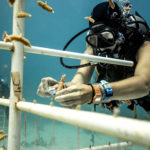
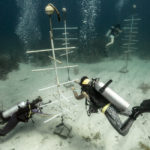
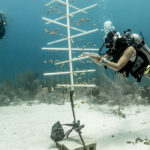
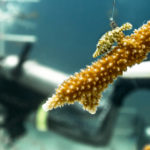
Why are they so popular?
Multiple studies indicate that these restoration methods are very effective. Furthermore, it causes no excess damage to fragments or donor colonies. Once out-planted, corals behave just as wild colonies. Acropora restoration projects in the Caribbean prove that coral nurseries are one of the most effective methods of restoration, as approximately 90 percent of out-planted corals survive and thrive once back on the reef.
Where are the successful nurseries?
In the Americas, Coral Restoration Foundation (CRF) is the longest-running with over 10 years of work and nurseries in nine different places. In Honduras, the Utila (UCR) project and Roatan (Bay Islands Reef Restoration) are ongoing.
How can divers support them?
Divers can help by learning how to minimize their impact while diving, following Project AWARE’s 10 Tips for Divers and using reef-friendly sunscreen like Stream2Sea. Donating both your time and money to projects in need is helpful as well.
Learn more
A quick internet search for coral-restoration projects or coral nurseries provides a list of resources. You can contact CRF in the United States and visit their website to see opportunities and locations for volunteering. The Utila Coral Restoration project in the Caribbean offers two courses:
PADI Coral Nursery Maintenance Distinctive Specialty
In this distinctive specialty you will learn about the various methodologies available when carrying out restoration efforts. In addition, you will learn about the process of maintaining the corals and monitoring the fragments within the nursery. You will visit our coral nursery and help us do routine maintenance.
PADI Coral Out-planting Distinctive Specialty
In this distinctive specialty you can learn about and practice the process of out-planting coral back onto degraded reef areas.
By Daniela Mejia and Andy Phillips
The post What are Coral Nursery Projects? appeared first on Scuba Diver Life.
from Scuba Diver Life http://bit.ly/2UKSNYW
Saturday, April 6, 2019
Top Five Coral Dives in Vanuatu
As home to the SS President Coolidge, one of the world’s largest intact WWII wrecks, Vanuatu is famous for its wreck diving. But it’s worth exploring the island’s amazing reefs as well. Here are our picks for the top five coral dives in Vanuatu.
Bonzer Wreck anemone garden, Hideaway Island, Efate
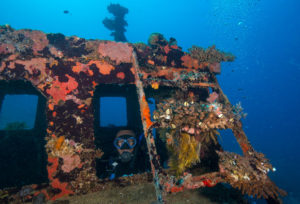
The Bonzer wreck is covered in coral
Yes, it’s a wreck, but it’s a very pretty wreck, with one of the largest anemone gardens you’ll ever see. In fact, everywhere you go in Vanuatu, you’re likely to find anemone gardens in the shallowest parts of the reef, even on the Coolidge. One of the largest however, is next to the Bonzer.
On top of a large coral bommie, this bright-orange anemone garden is several feet in diameter. Dozens of clownfish live here, and they’ll all come out to say hello as you swim around in the clear, tropical water. In the gullies that surround the bommie, clouds of bright orange and purple basslets hover around soft corals. All sorts of butterflyfish flutter about.
Fan Garden, Aore Island, Espiritu Santo
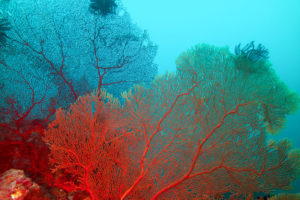
Aore Island fan garden
A few feet off the beach on Aore Island, you’ve got to see this drift dive to believe it. You’ll feel a bit like Alice in Wonderland as you drift with the current through a forest of seriously enormous sea fans.
Sometimes called ‘Aore Wall,’ in the shallows you’ll find nudibranchs, anemones and a variety of WWII artifacts. If you’re lucky, you might also spot a colorful mantis shrimp. It’s a great site for photographers looking to practice their macro skills or for those wanting to let the current do the work.
Tutuba Island, Espiritu Santo
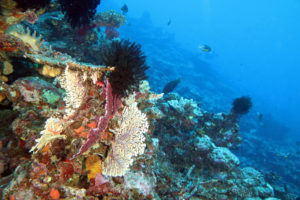
There’s plenty of coral at Tutuba Island
Tutuba Island is about a 30-40-minute boat ride from Espiritu Santo, and it’s fast becoming one of the most popular dive sites in the area. Once you’ve seen the Coolidge and Million Dollar Beach, get yourself a coral-fix here. Enormous plate coral fields and a seemingly endless variety of soft and hard corals lead into swim-throughs, gloomy trenches and caves where you can spot lobsters guarding their homes.
Above and off into the blue you can see schools of tropical fish and barracudas going about their business. Keep your eyes peeled as well for occasional eagle rays and reef sharks.
West Side Story, Hideaway Island, Efate
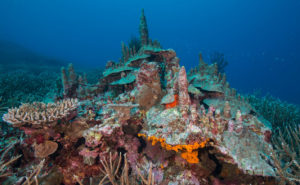
West Side Story
This seriously huge field of staghorn coral comes to within 20 feet (6 m) of the surface. Long fingers covered in yellow, blue and green staghorn coral drop down to a depth of more than 100 feet (30 m). Schools of pretty little damselfish swim just above the staghorn, which also conceals lots of anemones between the branching coral.
Despite the plentiful anemonefish here, this colorful site looks more like a scene from Disney’s “Sleeping Beauty” than “Finding Nemo.” At its center, a towering hard-coral structure resembles a fairytale castle, surrounded by forests of staghorn coral instead of thorny woods.
Owen’s Reef, Tranquility Island, Efate
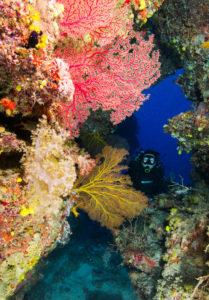
Owen’s Reef
This stunning spot is such a standout that a visiting marine biologist once remarked that he’d never before seen a dive site with greater coral diversity. It’s so remarkable, in fact, that you’ll want more than one dive to truly appreciate it.
The coral landscape changes with each corner you turn. You’ll see all sorts of hard corals including some enormous porites, brain, staghorn and table corals. Sheltering under the overhangs and inside tunnels you’ll find colorful soft corals. Where the coral meets a sandy sea floor at about 82 feet (25 m), large sea fans and whips sway in the current. Patient groupers and sweetlips wait their turn at the various cleaning stations around the reef.
Deborah Dickson-Smith is one half of Diveplanit, a dive travel website she manages with her partner Simon Mallender, based in Australia. Check here for more information on Vanuatu travel.
The post Top Five Coral Dives in Vanuatu appeared first on Scuba Diver Life.
from Scuba Diver Life http://bit.ly/2FYzXV7


